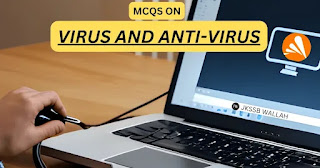MCQS ON VIRUS AND ANTIVIRUS
1. What is a computer virus?
a) A type of hardware component
b) A software that enhances system performance
c) A malicious program that replicates by infecting other programs
d) A type of operating system
The correct answer is c) A malicious program that replicates by infecting other programs.
2. Which of the following is a common way for viruses to spread?
a) Through telephone lines
b) By physical contact with an infected computer
c) Via infected email attachments
d) Through solar radiation
The correct answer is c) Via infected email attachments.
3. What does the term “Trojan horse” refer to in the context of computer security?
a) A type of antivirus software
b) A type of malware disguised as legitimate software
c) A tool used by hackers to communicate secretly
d) A computer virus that spreads rapidly
The correct answer is b) A type of malware disguised as legitimate software.
4. Which of the following is NOT a type of malware?
a) Virus
b) Worm
c) Firewall
d) Spyware
The correct answer is c) Firewall.
5. What is the purpose of an antivirus software?
a) To enhance the speed of the computer
b) To protect the computer from malicious software
c) To optimize hard drive storage
d) To improve internet connectivity
The correct answer is b) To protect the computer from malicious software.
6. What does a firewall do?
a) Blocks unwanted emails
b) Monitors network traffic and blocks unauthorized access
c) Cleans viruses from the computer
d) Enhances the computer’s performance
The correct answer is b) Monitors network traffic and blocks unauthorized access.
7. What is the role of real-time scanning in antivirus software?
a) Speed up internet browsing
b) Block advertisements on websites
c) Scan files as they are accessed to detect and prevent threats
d) Optimize system memory usage
The correct answer is c) Scan files as they are accessed to detect and prevent threats.
8. What is a “zero-day” vulnerability?
a) A vulnerability that has existed for a long time
b) A vulnerability that hackers are unaware of
c) A vulnerability that affects only old computers
d) A vulnerability related to network connections
The correct answer is b) A vulnerability that hackers are unaware of.
9. Which of the following is an example of a legitimate use of keyloggers?
a) Stealing personal information
b) Monitoring children’s online activities by parents
c) Slowing down computer performance
d) Enhancing the graphics of video games
The correct answer is b) Monitoring children’s online activities by parents.
10. What is a phishing attack?
a) A type of virus that spreads via physical contact
b) A social engineering attack to steal sensitive information
c) A type of antivirus software
d) A program that speeds up computer performance
The correct answer is b) A social engineering attack to steal sensitive information.
11. What is ransomware?
a) Software that increases computer speed
b) A type of antivirus software
c) Malware that encrypts files and demands payment for their release
d) A type of hardware component
The correct answer is c) Malware that encrypts files and demands payment for their release.
12. Which type of malware spreads by creating copies of itself in memory or on disk?
a) Spyware
b) Adware
c) Worm
d) Rootkit
The correct answer is c) Worm.
13. What is the primary purpose of a rootkit?
a) To improve system performance
b) To display unwanted advertisements
c) To hide malicious activity and maintain unauthorized access
d) To enhance the user interface
The correct answer is c) To hide malicious activity and maintain unauthorized access.
14. What does the term “heuristic analysis” mean in the context of antivirus software?
a) The analysis of historical virus outbreaks
b) The analysis of network traffic patterns
c) The use of algorithms to identify new and unknown threats
d) The analysis of computer hardware components
The correct answer is c) The use of algorithms to identify new and unknown threats.
15. Which of the following is a common way to keep antivirus software up to date?
a) By installing more RAM
b) By upgrading the graphics card
c) By regularly downloading and installing virus definition updates
d) By replacing the hard drive
The correct answer is c) By regularly downloading and installing virus definition updates.
16. What is the “quarantine” feature in antivirus software used for?
a) To enhance the computer’s performance
b) To delete all infected files immediately
c) To isolate and store infected files in a secure location
d) To optimize internet browsing speed
The correct answer is c) To isolate and store infected files in a secure location.
17. What is the purpose of a “signature-based” detection method in antivirus software?
a) To scan for new and unknown threats
b) To analyze network traffic
c) To enhance system performance
d) To identify known patterns of malicious code
The correct answer is d) To identify known patterns of malicious code.
18. Which of the following statements about antivirus software is true?
a) Antivirus software can only detect viruses, not other types of malware
b) Antivirus software is always 100% effective at stopping all threats
c) Antivirus software only works if the computer is connected to the internet
d) Antivirus software should be used in conjunction with other security practices
The correct answer is d) Antivirus software should be used in conjunction with other security practices.
19. What is the primary goal of a virus writer?
a) To create software that improves computer performance
b) To gain unauthorized access to computer systems
c) To improve the user interface of operating systems
d) To create legitimate and useful software applications
The correct answer is b) To gain unauthorized access to computer systems.
20. Which of the following is a characteristic of a polymorphic virus?
a) It infects only one specific file type
b) It changes its code to avoid detection
c) It is always easily detected by antivirus software
d) It only spreads through physical contact
The correct answer is b) It changes its code to avoid detection.
21. What is the main difference between a virus and a worm?
a) Viruses require human intervention to spread, while worms spread on their own
b) Viruses are always benign, while worms are always malicious
c) Viruses spread only through email attachments, while worms spread through networks
d) Viruses target hardware, while worms target software
The correct answer is a) Viruses require human intervention to spread, while worms spread on their own.
22. What is the purpose of an “antimalware” program?
a) To increase the speed of the computer
b) To remove legitimate software from the computer
c) To protect against various types of malicious software
d) To optimize system registry settings
The correct answer is c) To protect against various types of malicious software.
23. Which of the following actions can help prevent computer infections?
a) Sharing personal information on social media
b) Downloading software from unofficial sources
c) Keeping software and operating systems up to date
d) Disabling firewall and antivirus software
The correct answer is c) Keeping software and operating systems up to date.
24. What is a “drive-by download” attack?
a) A type of virus that spreads via USB drives
b) A social engineering attack targeting specific individuals
c) A type of attack that infects a computer without the user’s knowledge while visiting a compromised website
d) A method used by antivirus software to scan external drives
The correct answer is c) A type of attack that infects a computer without the user’s knowledge while visiting a compromised website.
25. What is the purpose of sandboxing in antivirus software?
a) To create a virtual environment for gaming
b) To optimize system resources
c) To isolate and analyze potentially malicious files in a secure environment
d) To increase the speed of internet browsing
The correct answer is c) To isolate and analyze potentially malicious files in a secure environment.
26. What is a “false positive” in the context of antivirus scanning?
a) A legitimate file incorrectly identified as malware
b) A type of malware that only affects specific applications
c) A virus that appears harmless but later causes damage
d) A type of malware that affects only older computers
The correct answer is a) A legitimate file incorrectly identified as malware.
27. Which type of antivirus scan examines all files on the computer’s hard drive?
a) Quick scan
b) Custom scan
c) Full scan
d) Real-time scan
The correct answer is c) Full scan.
28. What is a “signature” in the context of antivirus software?
a) A digital certificate used for secure online transactions
b) A unique identifier for a computer virus
c) A type of encryption algorithm
d) A type of network protocol
The correct answer is b) A unique identifier for a computer virus.
29. Which of the following is an example of a self-replicating virus?
a) Ransomware
b) Adware
c) Spyware
d) Sasser
The correct answer is d) Sasser.
30. What is the main purpose of an antivirus scan?
a) To optimize computer performance
b) To identify all running processes
c) To detect and remove malicious software
d) To improve the user interface
The correct answer is c) To detect and remove malicious software.

